Table of Contents
- SaaS link building drives traffic, authority, and brand awareness through targeted, high-impact backlinks.
- Tactics like broken link building, unlinked mentions, and link reclamation work best for established SaaS brands.
- Content-driven approaches (reports, tools, guest posts) are scalable and build both links and leads.
- Tools like Ahrefs and BuzzStream streamline prospecting, outreach, and campaign tracking.
- Not ideal for early-stage or ultra-niche SaaS without a strong content base or existing brand presence.
Building links has benefits outside of just helping you rank for keywords. Link building is integral to getting your business online exposure. The right link can attract new customers in a way that other forms of organic marketing simply cannot.
Link building can be especially beneficial in competitive industries like SaaS. Yet, many SaaS marketers don’t utilize it in their marketing mix.
If you are one of those marketers hesitant to wade into link building for SaaS business, we’re here to tell you that it’s an accessible and doable strategy. We also did an entire analysis of the top SaaS link builders.
Use these SaaS link-building tips, ideas, and real-life examples to learn how to put space between yourself and your competitors.
What is Link Building For SaaS?
Link building for SaaS is actively or passively acquiring links to your website. Building relevant links can help you rank better for key terms, increase traffic, and build brand awareness.
Later in this post, many examples show how major SaaS companies have leveraged links to bring significant links from news sites and build valuable organic traffic.
9 SaaS Link Building Strategies, Ideas, and Examples
SaaS link-building is different in that specific tactics work better for SaaS companies. Generally speaking, the SaaS industry can be more competitive because there are a lot of similar products vying for the same spots or niche industries.
That’s why many review sites like G2, Capterra, or Trust Radius exist. But, at the end of the day, the goal is simple: build links to get your product noticed.
There are more than eight ways to build a link, but below, you’ll find scalable, repeatable tactics that have proven successful for hundreds of SaaS companies. Not every tactic will fit each brand, and each requires a different amount of effort to see success, so we’ve highlighted this in the breakdown below.
Here are some real-life examples from SaaS brands.
1. Broken Link Building
Who is it best for? Most sites
Effort required to see results? Med-High
Broken link building is finding a broken link on another website and offering to replace it with a link to your website.
You can go about this in a few different ways:
DIRECT: Find a piece of content that is no longer live but still has a lot of backlinks and build a replacement.
INDIRECT: Find a relevant website in your industry with a broken page link. Then, email that website to point out the broken link and use that as a jumping-off point to pitch them your site or content.
Either way, you are providing the site with something of value in hopes that they will return the favor.
The direct approach is more common.
Here’s how to do it:
Open Ahrefs, go to Content Explorer, and enter a relevant post topic you could create. Then, choose “Only Broken” to display assets that are currently 404ing. Then, sort by Referring Domains.
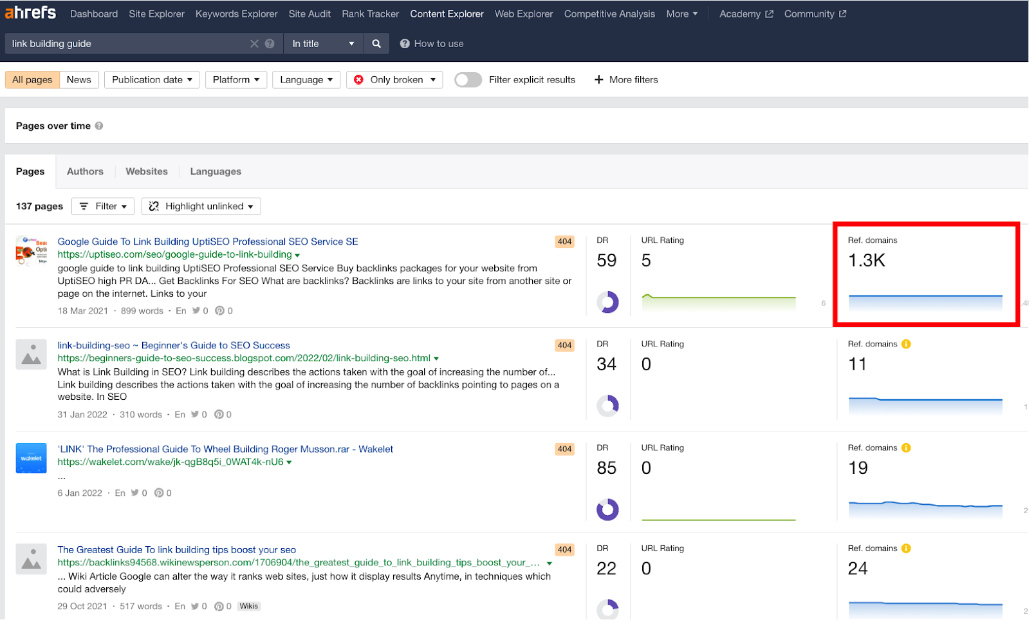
Once you confirm it is dead, check the links to verify whether they are accurate and relevant.
Once confirmed, build something similar or better!
For example, in the screenshot below, we searched for “link building guide” and found one broken asset with 1.3K links.
(Upon digging further, we confirmed that all 1.3K links are spammy, so it’s important to check!)
Once you have your replacement piece of content, export the list of backlinks to the 404ing page.
With this in hand, you start finding email addresses for all the sites linked to the now-defunct page.
You can find emails with a variety of tools, including Buzzstream.
Once you have the email address, your outreach email will look something like this:
Hi [Website Owner’s Name],
I recently stumbled upon your website while researching [topic/industry]. While exploring your content, I noticed a broken link that caught my attention.
Specifically, I found that the following page on your site has a broken link:
- [Page URL with Broken Link]
I have a replacement link that could fit into the context of your article.
You can see it here: [YOUR RESOURCE]
Would you be interested in replacing the broken link with my suggested resource? It would benefit your readers by offering up-to-date and relevant information.
Thanks!
TIP: You may send a high volume of emails for broken link-building, which can make it feel less effective. Focus on building your workflow.
Use a tool like Buzzstream to track your progress, templatize your emails, send emails, and schedule follow-ups.
2. Unlinked Brand Mentions
Who is it best for? Sites with brand recognition
Effort required to see results? Low
Finding unlinked brand mentions is like stumbling across free money in the street. It’s easy, it’s free, and it’s effective.
However, finding unlinked brand mentions requires recognition in the market.
Simply put, you can’t claim a link if no one is talking about you.
(It can also be a problem if you have a website whose name is a ubiquitous word, like Stay, Move, or Fun.)
Here’s how to do it:
To find your unlinked brand mention, you can try a few methods:
- Search Google for your brand
- Set up Google, Talkwalker, or Ahrefs alerts for your brand
- Search for your brand on Ahrefs’ Content Explorer using your brand name -yourwebsite.com.
Let’s look at #3 below for Buzzstream using Ahrefs.

For example, here is an unlinked mention of Buzzstream.
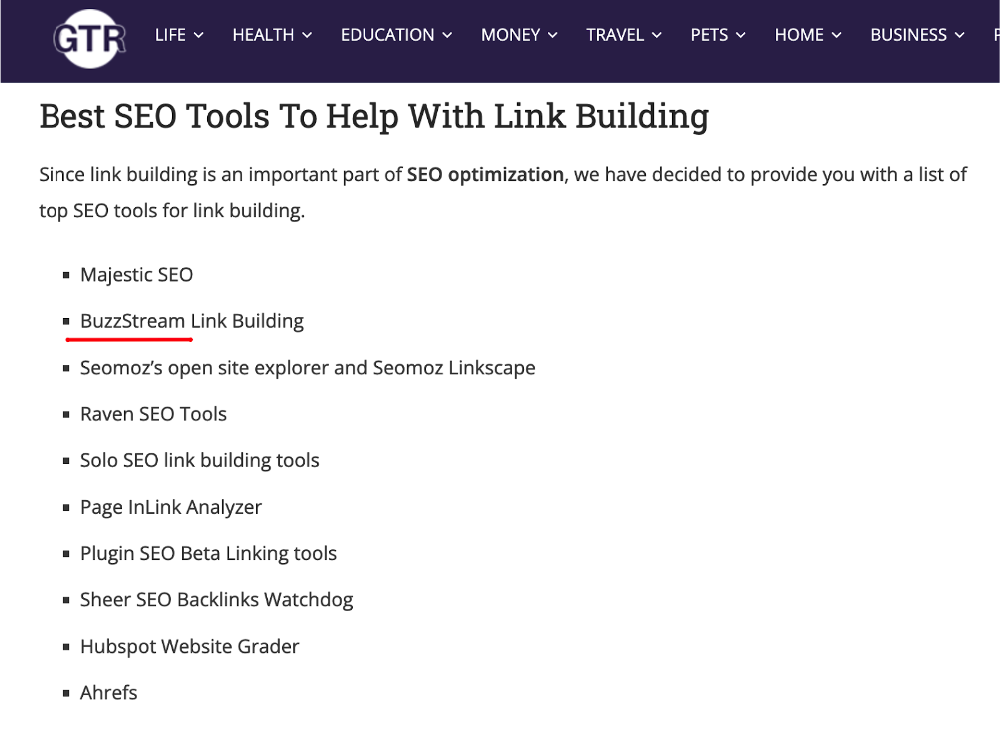
Once you find an unlinked brand mention, you can email the website owner and ask them if they’d be open to adding a link to your website. Some may request money, and others may do it for free.
An email for this would look something like this:
Hi [Website Owner’s Name],
I was thrilled to see your mention of [Your Brand] in [Article Title]. I noticed it needs a direct link to our site.
Would you be open to adding a hyperlink for better reader access? I can provide the necessary details.
Please let me know your thoughts.
Thanks!
3. Link Reclamation
Who is it best for? Sites that have been around for a while and have a backlink profile
Effort required to see results? High
Link reclamation is like an unlinked brand mention’s cousin. You are still reaching out to a site and asking them to link, but in this case, you are reaching out because they used to link to you but no longer do.
Websites lose backlinks all the time. Usually, it’s because of a technical change or content update. Sometimes it’s on purpose. Luckily, there are ways to get them back.
Here’s how to do it:
We have a whole post which lays out the full link reclamation process, but in essence:
- Find a site that linked to you but no longer does
- Reach out to them and request that they add the link back.
You can find lost links using Ahrefs’ Site Explorer. Enter your domain and choose “Lost” links.
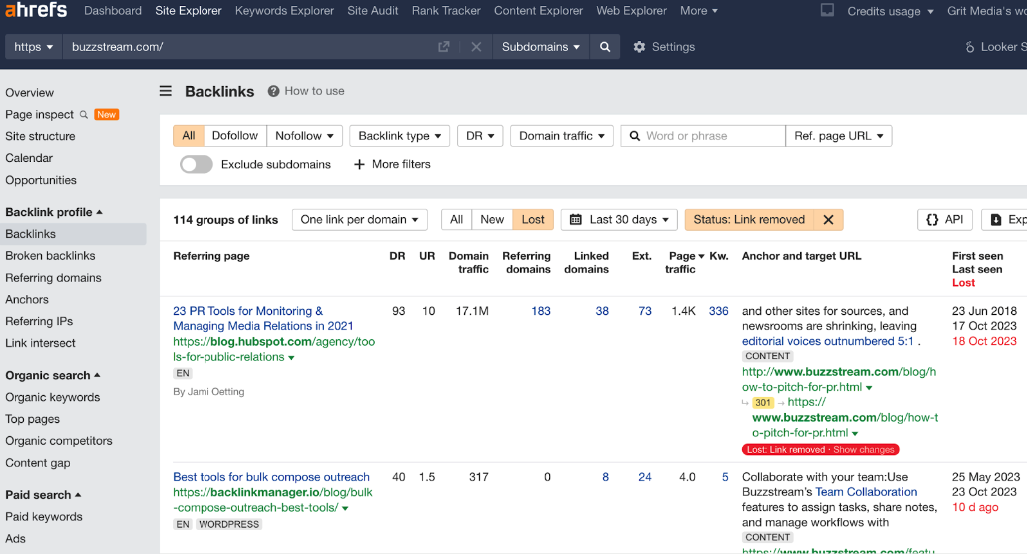
Once you find the site, double-check that they no longer link to you.
Then email them with an email that looks something like this:
Hi [Website Owner’s Name],
I noticed that your article [Article Title/URL] used to feature a link to [Your Website], but it seems to have been removed.
Our content has evolved, and we believe it could still be a valuable resource for your readers. Could we kindly ask you to reinstate the link?
Here’s the updated URL: [Your Correct URL].
We greatly appreciate your consideration. Feel free to reach out if you need any additional information.
Thanks!
4. Websites Where Your Competitors Appear (But You Don’t)
Who is it best for? Sites with lots of close competitors
Effort required to see results? Med-High
You could also call this tactic the “FOMO link-building strategy” because you are looking for list posts or resource pages that link to your competitors but not your site.
Finding websites takes some research, but there are some excellent tools to speed it up.
To find websites that link to your competitors but not you generally, you can try Ahrefs’ Link Intersect tool.
However, to get more specific, we recommend Ahrefs’ Content Explorer.
Here’s how to do it:
First, you’ll add the title of a post. For Buzzstream, it’s “Link Building Tools.” Then set it to search for the phrase “In title”.
The kinds of pages you are looking for are:
- Roundups/Lists
- Reviews
- Resources
- Recommended Links
- Recommended Tools/Software
Last, you’ll want to Highlight unlinked and add your website.
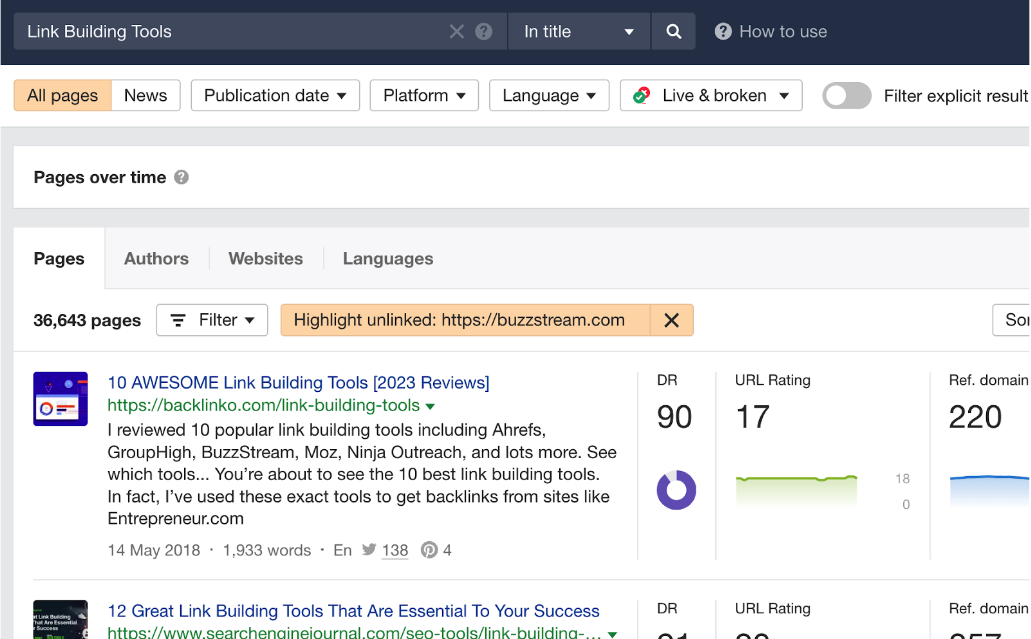
Unsurprisingly, you can see that some of our competitors who talk about “Link building tools” don’t link to us.
Once you find a page that makes sense, email them asking if they’d like to include a list.
Hi [Website Owner’s Name],
I just came across your article: [Article Title]. As we also operate in this space and offer a similar product, we’d love it if you’d consider including our site, [Your Website], in your list.
Either way, we’d love to offer you a free trial of our tool so that you can test it out for yourself.
Thanks for your consideration. Please let me know what you think.
5. Creating and Pitching Content
Who is it best for? Sites with an active blog
Effort required to see results? Med-High
Getting links to your homepage or high valued service pages are the best ways to convert customers. But these links take time to come by. So, most of the time, you must focus on top and mid-funnel content to get links. Then, internally link your content to your money pages.
Creating content is a great way to generate backlinks for SaaS sites. However, consider the adage: if a tree falls in the forest and no one can hear it, does it make a sound?
The same adage can apply to creating content for SaaS link building. If you make the best content in the world, but no one sees it, will anyone link to it?
The answer is usually no, meaning you need to do manual outreach.
Creating pitchable content is a topic in and of itself, but at its core, it needs something tangible that provides value to others.
Pitchable content in the SaaS world typically falls into one of these two (or sometimes multiple) buckets:
- Infographics/Animation/Videos/Data Visualizations
- Surveys/Reports
- Tools/Templates
- Interactives/Calculators
- Complete Guide
But before you create your content, you must ensure an audience exists. We recommend confirming that your idea has already gotten coverage by finding similar shared posts or assets.
Here’s how to do it:
Again, head to Ahrefs Content Explorer and enter your proposed topic idea. Then, sort by referring domains. Look for posts with lower page traffic numbers and high link numbers.
For example, here is a search around “link building report”, which is something that is of interest in our industry. It looks like Aira created a “State of Link Building 2022 Report” which built over 200 linking root domains.
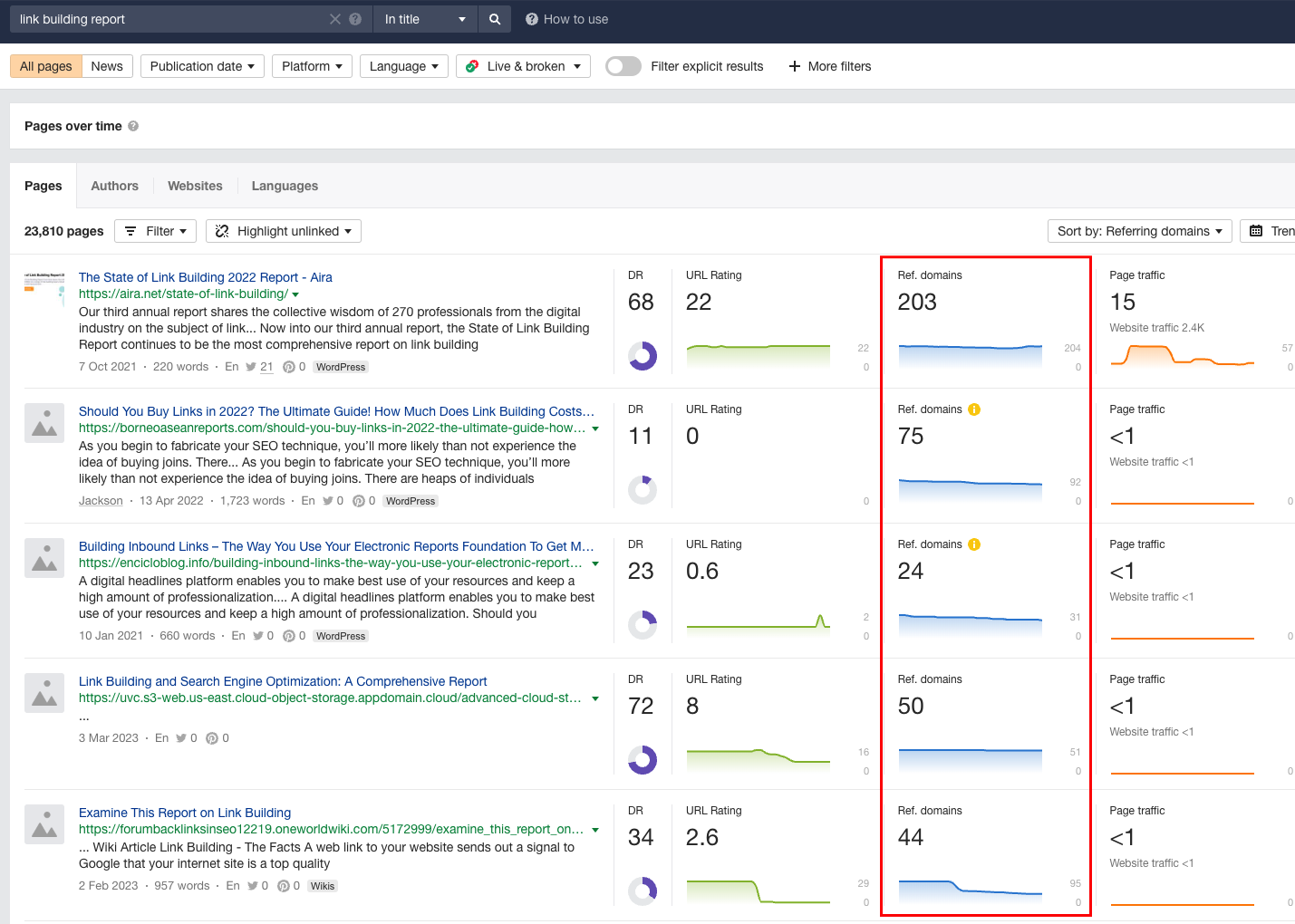
Pages with many links AND traffic/value are most likely generating links passively rather than through manual outreach (which is the next tactic.)
Once you’ve confirmed your idea, build your content. Then, use a tool like Buzzstream to pitch your content to your targets.
A pitch email for content you’ve created would look something like this:
Hi [Website Owner’s Name],
I saw you posted about [Related Topic] and thought you might be interested to see a similar post that we created at [Your Website]. [Explain the topic of your post in 1 sentence].
You can see it here: [Your Correct URL].
We’d be thrilled if you considered sharing this with your readers. Happy to provide any custom copy or assets that you might need for a post on your site.
Please let me know what you think!
6. Creating Content That Builds Passive Links
Who is it best for? Sites with a higher DA
Effort required to see results? Med-High
But wait, didn’t you just say if you create content without pitching it, no one will see it?
There is a lot baked into this strategy, so buckle up.
Some topics have inherent “linkability,”— meaning researchers, journalists, and bloggers often search for these topics when looking for citations. Therefore, topics that work for passive link building also have search volume attached to them.
The most obvious (and wholly exploited) example is “statistics” posts. But this also works for definitional posts, trends, facts, types, and other similar keywords.
Here’s how to do it:
To find keywords that can build passive links, head to Ahrefs Content Explorer and enter your proposed topic idea. Then, sort by referring domains. Look for posts with high page traffic numbers and high link numbers.
In the below screenshot, you’ll see some posts around “link building” bringing in organic traffic and links:
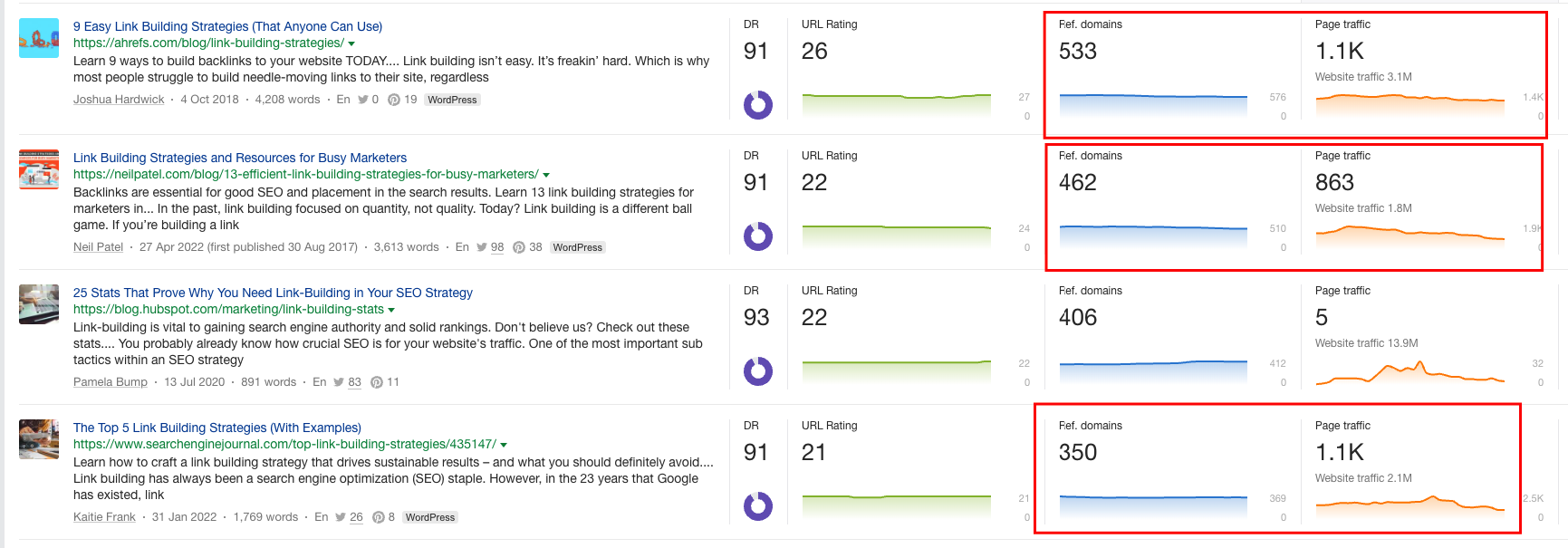
You’ll need a higher DA to gain traction from this approach. And it can take 8-10 months to start seeing links come in passively. So, this should be a supportive part of your content plan, not the only thing you do.
7. Guest Blogging Opportunities
Who is it best for? All SaaS sites
Effort required to see results? Med-High
Guest blogging involves writing guest posts for other high-quality websites in your industry. When you do this, you can include a link to your website in the author bio or the post itself.
Here’s how to do it:
To find sites that offer guest posting opportunities, use Google operators:
- your niche + guest post
- your niche + guest post guidelines
- your niche + contribute article
There are a few major red flags to look out for with guest posts. An entire industry of websites makes money solely by providing paid guest post opportunities.
Be wary of low-quality sites that offer guest posting. Although our study of link building pricing found guest posts cost an average of $220, this price will not get you the quality you need.
Carefully evaluate each site for E-E-A-T signals. And remember, if anyone can write a guest post to the site you are looking for, the link probably isn’t all that valuable.
You can also find opportunities from our analysis of 150+ guest post sites.
8. Expert Quote Requests
Who is it best for? Sites with products/services that tie into industry news
Effort required to see results? Med-High
Several free and paid services connect journalists with experts who can provide them with quotes for their articles.
These requests are great opportunities to gain backlinks from high DA sites.
When you sign up, you can receive email alerts whenever a journalist is looking for an expert on a topic you know about.
Here’s how to do it:
Sign up for Helpareporter, Qwoted, and Featured. You’ll receive daily/weekly requests from journalists.
When you find one that makes sense to pitch, be direct, but try to stand out. Journalists usually get many responses.
Tip: Two tips, really — first, sometimes the links are nofollow, which isn’t necessarily a deal breaker as nofollow links can still get you brand exposure and clicks back to your site. Second, you must be incredibly quick to get your quote in there. Journalists are usually on tight deadlines.
9. Link Exchanges
Who is it best for? Sites of any level or size (but best for you to find the highest quality SaaS companies)
Effort required to see results? Low
I haven’t mentioned link exchanges until now because I am not as sold on their value as a long-term strategy. The obvious downside for me is that link exchanges have recently ventured into the realm of private blog networks.
Most exchanges come in the form of a list of domains on a shared spreadsheet like the one you see below:
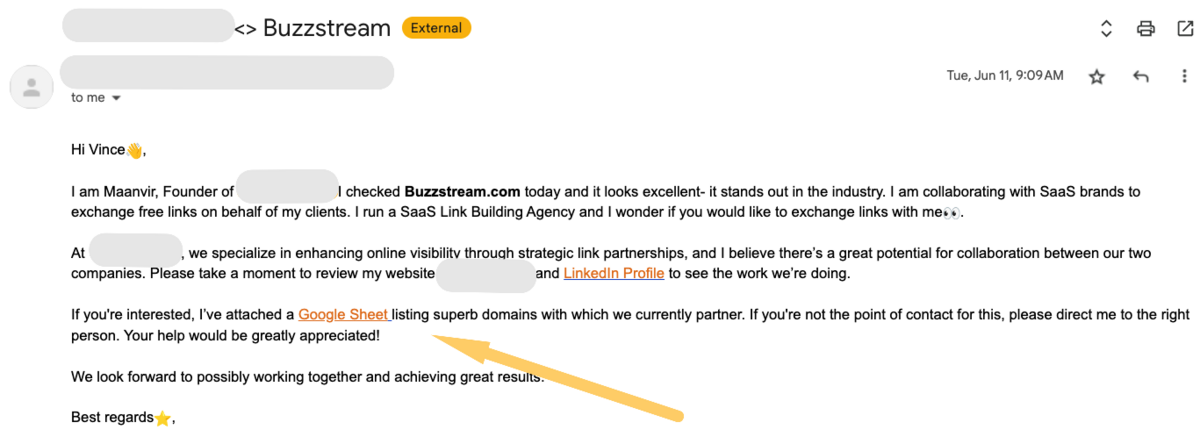
Instead of natural reciprocal links, you can choose from a list of sites to partner with. This, in turn, gets you on the list for others to partner with. And that’s where it gets spammy.
Treat link building with link exchanges as an opportunistic tactic; if someone naturally offers one while doing outreach, you can consider it. But, you should always vet the quality and relevancy of the site itself. If it feels too forced or transactional, then avoid it.
Here’s how to do it:
The most direct way is to find a high-quality, relevant site and ask to trade links. But there is a much more natural way: Mention a site naturally in a post on your website. (This can be a list post, like our best digital PR tools post, or a statistics post, like our link building statistics post. )
Then, reach out to that site and let them know that you mentioned them.
Great Examples of SaaS Link Building
Here are some examples of SaaS link-building in action:
1. Shopify’s Business Name Generator is a Passive Link Generator
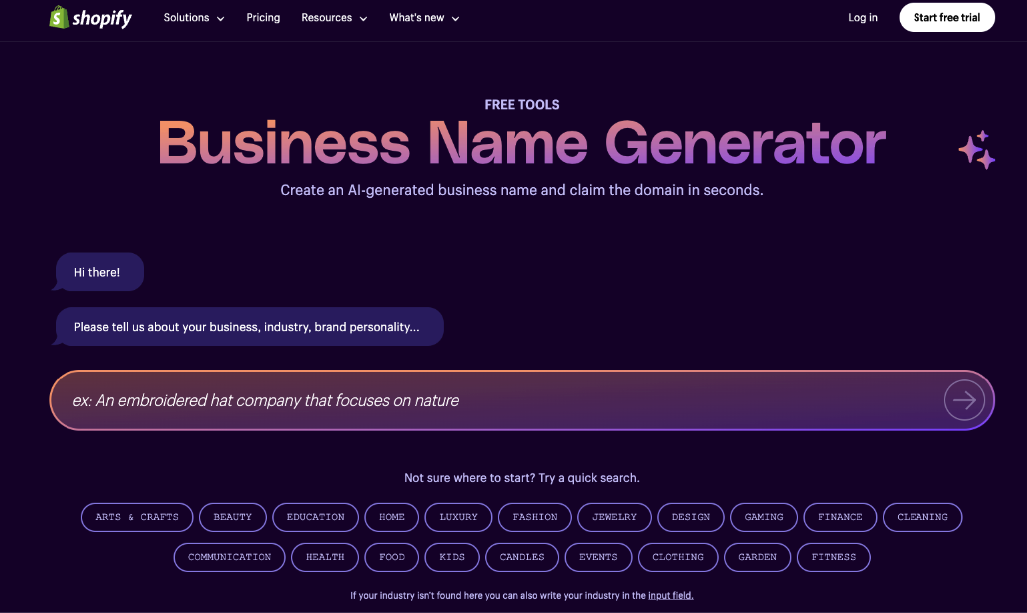
Shopify has created a suite of business tools, including this business name generator. Not only is it a beautifully designed, helpful resource, but the keyword it ranks for, “business name generator,” gets 71K monthly searches. The fact that it is now AI-powered makes it even more impressive.
You can see that it has slowly gained backlinks over the years and now has over 2.8K.

Takeaway: Find an idea with a lot of utility and marry it with search volume. Then, don’t skimp on the design and usability.
2. HubSpot’s Content & Media Strategy Report is a Pitchable Asset
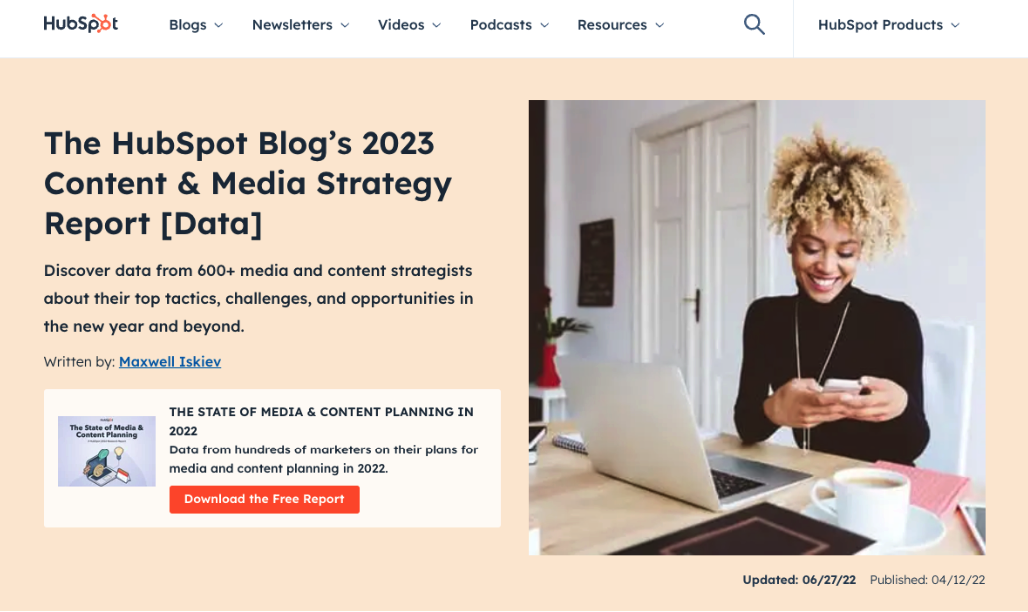
HubSpot has dominated the industry by consistently generating industry reports like their Content & Media Strategy Report that they can pitch for links. They most likely don’t pitch them at this point because they’ve established a cadence for releasing reports, and news outlets know to expect it.
Takeaway: Reports are great link magnets. If you can create several and develop a steady cadence, eventually, outlets will anticipate and link without you needing to pitch.
3. BambooHR Guest Blogs on Other Sites
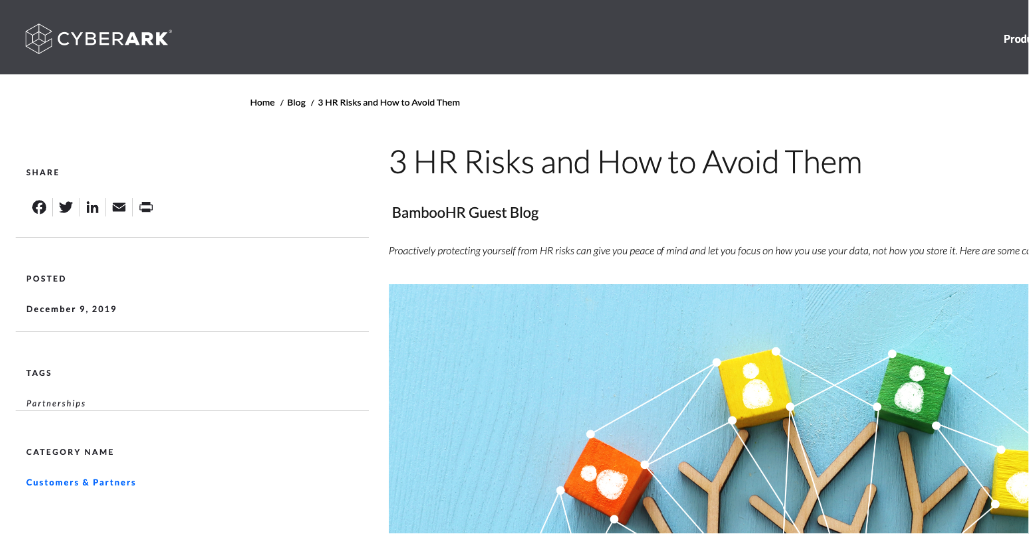
BambooHR is an HR SaaS company, and CyberArk is an Identity Security service. So, seeing their audiences overlap, BambooHR likely reached out to see if CyberArk would be open to a guest post. (CyberArk directly integrates with BambooHR, making it a natural fit.)
Takeaway: Guest posts provide the most significant value when your customers directly overlap. Also, look for link opportunities from websites whose technologies or data you may utilize.
4. Talkwalker’s Free Tool Gets Links and Potential Full-Paying Customers
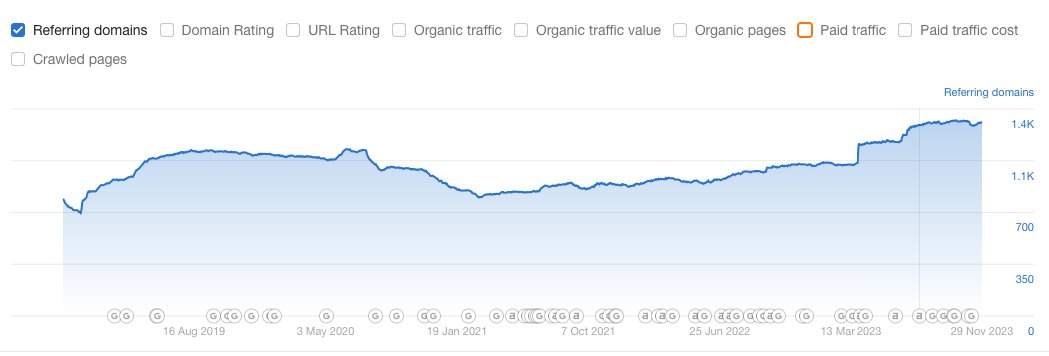
Talkwalker is a social listening and media monitoring SaaS software. By offering a free version of their primary tool, potential full-paying customers get a taste of what their software can do. Then, free users become qualified leads. Since their tool is so helpful, it also generates a lot of links and has built over 1.7k linking root domains over the years.
Takeaway: Tools make for great link-building assets. If you can tie that tool directly to your SaaS business, you can generate potential leads.
When is Link Building Not a Good Idea for SaaS Businesses?
There are a few potential reasons that link building might not be a good idea for your SaaS business:
You are a new site or an unestablished product
Link building can’t hurt you, but it may not be the most efficient use of your resources early on.
Your product offers a highly niche solution
Again, link building can’t hurt you here, but finding relevant sites to get links from will be a lot harder. Broad-scale link building might not yield the returns you seek due to the limited audience.
You rely heavily on direct sales or referrals
Some SaaS businesses may rely more heavily on direct sales or referrals than online visibility, so investing in link building isn’t worth it.
“I regularly tell SaaS founders they’re not ready for link building yet,” Philip Ghezelbash, founder of SaaS Backlinks, told me. “If you don’t have solid content, clear positioning, or basic technical SEO handled, links won’t save you. They amplify what’s already working, they don’t fix what’s broken.”
Frequently Asked Questions about SaaS Link Building
How is SaaS link building different than other industries?
SaaS products sometimes have more difficulty building links organically because their products can be so niche.
SaaS link building is also different from other industries in that it needs to focus on building links to authoritative content that is relevant to the business needs of B2B buyers. It also needs to focus on building long-term relationships with journalists, bloggers, and other influencers who can help SaaS companies reach their target audience and generate leads.
Does link building still work?
Link building still works, but how it works has changed significantly over the years. In the past, simply getting a lot of links to your website, regardless of the quality or relevancy of those links, could help you rank higher.
However, search engines have become much more sophisticated and now focus on the quality of links rather than just the quantity.
What is link-building software?
Link-building software is any tool that automates and streamlines the link acquisition process. The software can help save time, increase efficiency, and improve results in many ways: identify relevant websites for guest posting, research contact info, create email outreach campaigns, and track progress. Ahrefs, SEMRush, Hunter.io, Screaming Frog, and are all examples of link-building software.

 End-to-end outreach workflow
End-to-end outreach workflow



 Check out the BuzzStream Podcast
Check out the BuzzStream Podcast







